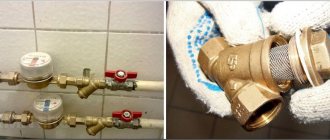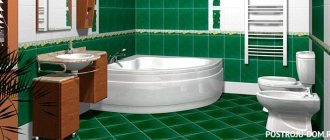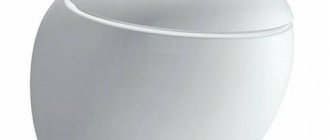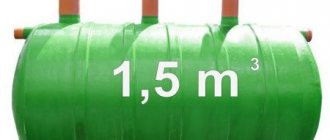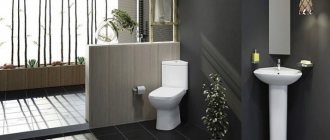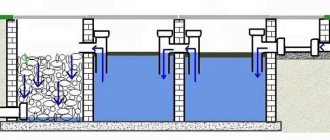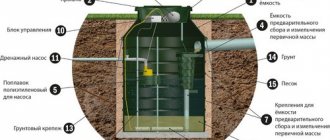A toilet with a vertical outlet to the floor is not the most popular modification of this product.
But there is a buyer for any product.
Under certain conditions, this model will be the most suitable.
Let's talk about the features of such toilets and learn how to choose and install them correctly.
Types of toilets
Before you figure out how to install the product , you need to understand how to choose the right toilet. The location of the outlet and the fastening of plumbing products are of great importance. Currently, manufacturers produce several types of toilets:
- horizontal release;
- inclined;
- vertical.
The first type of products is the least common. The pipe in this configuration extends horizontally from the bowl. In order to carry out high-quality installation of such plumbing equipment, it is necessary that the sewer pipe passes slightly below the outlet.
The most common type of product is toilets with an inclined outlet. Such devices are a little similar to horizontal models. However, unlike them, these products have a pipe located at a slight slope. equipment is in great demand among apartment owners , since toilets of this type can be connected to any sewer system without any problems.
Certain difficulties arise for the owner of an urban home when he installs a toilet with a vertical outlet. And here it is extremely important that the sewer pipe runs away from the wall.
products with a bottom outlet from each other not only in the fastening and outlet, but also in the shape of the bowl. This point is extremely important in ensuring comfortable use of the product, as well as in terms of saving water.
According to the bowl shape, toilet bowls currently produced are of the following types:
- with a plate bowl;
- visor;
- with a funnel-shaped bowl.
A feature of toilets of the first type is the presence in the bowl of a small depression in which water is constantly located. The drain is located closer to the edge of the toilet. Draining requires a lot of water, and in addition, during the operation of the product, its contamination occurs much faster.
The canopy toilet used to be called Finnish. This name was assigned to it for the reason that in the Soviet era, plumbing products of this type were not produced in our country. The convenience of such a toilet lies in the fact that it has steep walls, which makes flushing faster and easier, and this makes it possible to save water .
How to select models based on flush type?
According to statistics, toilets are replaced every 10-15 years. Therefore, it makes sense to take the trouble to find the right model in order to provide yourself with decent living conditions for many years.
Plumbing fixtures differ in many ways:
- bowl shape (visor, dish-shaped, funnel-shaped);
- fastening (floor-mounted, side-mounted, suspended);
- material (porcelain, earthenware, artificial stone);
- flush;
- wastewater discharge (new universal type - vario; usual types: vertical, horizontal, inclined).
Devices are chosen depending on personal preferences, ideas about convenience and aesthetics. As for the type of waste discharge, they focus only on sewerage distribution.
If drastic changes are not planned in the sewerage system, it is better to buy a toilet with the same outlet as the old one. Otherwise, there will be additional costs for reworking the system.
The only universal device is a toilet with a vario release. Such models have appeared recently, they are still difficult to find, but can already be bought in plumbing stores.
The edge of the outlet is located at the maximum possible distance from the rear edge of the device, which makes room for any type of pipe. Another advantage of the vario is the ability to install the toilet close to a partition or wall.
When choosing a model based on the type of release, you should remember that toilets are not interchangeable. Without redesigning the sewerage system, it is impossible to install a device with a vertical outlet instead of a horizontal one, although replacement with an oblique or vario is quite affordable. Ideally, you should buy plumbing fixtures of the same type, otherwise there may be problems not only with installation, but also with operation.
Material for toilets
The material of the plumbing fixtures is an important criterion that should definitely be taken into account when choosing a toilet with direct release. Currently, manufacturers produce the following types of toilets:
- earthenware;
- porcelain;
- from artificial stone.
Low price characterizes earthenware sanitary products. They are highly resistant to household chemicals . Among the disadvantages of these products is the presence of a porous structure of the material, which ensures rapid contamination of the surface of the toilet bowl with direct release.
Compared to earthenware, porcelain counterparts are more expensive. However, they are more hygienic products, since they attract dirt to their surface to a much lesser extent.
Manufacturers have recently launched the production of toilets with direct release from polymer concrete. Along with the beautiful texture of this material, it has only disadvantages. It is not highly resistant to acids and alkalis, as well as abrasive materials, so cleaning such a product from contamination turns into a rather difficult task .
Connecting the tank to the water supply
At the last stage, the drain tank is connected to the cold water supply system, for which they usually use a flexible hose with nuts at both ends. For sealing, select rubber gaskets or use a special FUM tape.
It is advisable to install a shut-off valve on the pipe supplying cold water to the tank. This will allow you to locally shut off water in one place for repairs and maintenance of the product, while other water collection points will operate as usual.
When can you not do without a vertical outlet?
Toilets with vertical flush have the main advantage that installation of the product is quite simple. In order for the product installed in the bathroom to last a long time and be reliable, you must choose:
- sanitary fixture made of porcelain;
- a toilet equipped with a circular flush, which ensures washing of the entire surface of the bowl;
- There should be a water mirror at the back of the product along with the anti-splash device. Then, when flushing, there will be no splashes, and in addition, the quality of the flush will be high;
- The drain tank must be secured to the plumbing fixture with reliable components.
Sometimes situations arise when installing a product that has a vertical outlet is the most suitable solution. Quite often, such devices are purchased for installation in bathrooms in which the pipe is located flush with the floor. In Stalinist buildings this system was the most common.
In bathrooms in new houses, you may find that the sewer pipe is located above the floor level. This makes it possible to use a toilet of any design. The product, which has a vertical outlet, is most often purchased by owners of private houses . They make this decision for a number of reasons:
- installation of such a device makes the sewer pipe invisible. As a result, the bathroom looks quite attractive;
- in private houses there is usually a basement under the house, which provides a good opportunity for sewer repair work.
How to properly care for a new device?
Plumbers recommend installing coarse filters along with the new toilet. Tap water contains solid particles and pieces of scale from metal pipes. Getting into the tank along with debris, it provokes abrasion and premature wear of parts.
If the filter is not installed, you should take care to timely clean the drain tank so that you do not have to repair or replace damaged elements ahead of time. The structure is disassembled, limescale is removed, and the parts are washed with clean water.
You can remove limescale deposits by throwing a special tablet into the storage container. It will dissolve water stone, clean and disinfect the tank, and flavor the water. Citric acid is suitable as a folk remedy.
To avoid leaks at the junction with the sewer, preventive maintenance must be carried out. A pipe cleaning chemical (“Mr. Muscle”, Tiret, “Chister” or any other) is poured into the toilet and left for the time indicated on the package. Aggressive substances corrode plaque on the walls, which prevents blockages.
It is not necessary to spend large sums on store-bought household chemicals. Baking soda and vinegar can give the same result: flush pipes, disinfect, eliminate odors
You need to clean the toilet at least a couple of times a year. It is important to choose the right products, taking into account the characteristics of the materials from which the pipes and the device itself are made.
Equipment installation process
The high demand for toilets with a vertical outlet to the floor is also due to the fact that such a product can be installed with your own hands without any difficulty.
In this case, there is no need to install the device near one wall. The peculiarity of such models of plumbing fixtures is that they have a built-in siphon and outlet pipe. These elements are located directly in the toilet bowl.
In order for the installation of a plumbing fixture to be successful, this work must be performed in a certain order.
- The first step is to dismantle the old product;
- After this, the installation site is prepared, followed by marking the base;
- Next comes the installation and fastening of the toilet;
- All joints must be sealed;
- The next step is to connect the device to the sewer;
- Next, the drain tank is installed;
- After this, you need to establish a connection.
Removing an old toilet
To install a new product, you must first remove the old one. Correct execution of this operation is possible if you adhere to the following instructions:
- It is necessary to turn off the water present in the tank and drain the liquid.
- Then you need to remove the tank.
- If an old product is fixed to cement, then it must be removed in such a way that the integrity of the pipe is not compromised. Using a chisel and hammer, knock down the solution. Then you need to gradually remove the product from the pipe.
- After this, you need to tilt the plumbing fixture slightly so that the remaining water leaves the pipe.
- By rocking slightly, you need to remove the toilet.
Installing a toilet with direct floor outlet
When the task of removing the old product is completed, you can proceed to installing the new device. This can be done without involving specialists. The most important thing is to adhere to the following recommendations.
- The first thing you need to do is take measurements and mark the place where the toilet and outlet pipe will be located.
- After this, a flange with a lock must be installed in a pre-marked location. It has a round hole. A sewer pipe must be installed in it.
- Next, you need to perform the installation. With a slight turn, complete fixation of the exhaust pipe will be ensured, which will be automatically pressed to the sewer pipe with a special sealing ring. After this, the work can be considered completed.
- The use of a special connection when installing a toilet with a floor outlet makes it possible to quickly replace the product. The connecting parts are located at the bottom, so the outlet is practically invisible and the product has an aesthetic appearance.
Replacement with a model with a different drain
Is it possible to replace a device with a vertical outlet with a model with a different type of drain? Yes, if the area and location of the plumbing allows you to move the toilet by at least 15-20 cm. To connect to the sewer, you will need a plumbing corrugation.
- The old toilet is being dismantled. A new one is placed in its place so that it is as close as possible to the sewer pipe.
- The pipe of the device is coated with silicone sealant, and a corrugation is put on it.
- The second end of the corrugation is inserted into the sewer pipe and fixed.
The folds of the corrugation should straighten without dents. It is necessary to ensure that its slope is directed towards the sewer pipe.
Types and standards
The plumbing equipment market keeps up with the times, constantly offering customers new toilet configurations. This should not be alarmed, because, despite the wide variety, all equipment is manufactured on the basis of certain norms and standards. When dividing toilets into general groups, the following are distinguished:
- funnel-shaped design;
- toilets with shelf;
- toilets with a sloped back wall;
- equipment with horizontal drainage;
- equipment with a circular drain.
funnel-shaped
Funnel-shaped structures are considered one of the most common on the market, and their high demand is achieved due to the simplicity of the design and its hygiene.
With shelf
Toilets with a shelf are considered to be old designs that are gradually going out of use. The shelf prevents the formation of a splash during operation, but has low hygiene. Waste is washed away only under the influence of high water pressure.
With a sloped rear wall
Toilets with a sloped back wall are replacing similar products with a shelf due to a well-chosen ratio of hygiene and splash protection. Such designs are recommended for use by both professional plumbers and ordinary citizens.
Horizontal drain
Toilets with horizontal flush belong to the budget category of plumbing. In this modification, water washes only one wall, which reduces hygiene. The advantages include:
- durability;
- low cost.
The disadvantages include:
- noise during draining;
- strong splashing of water.
Circular drain
In toilets with a circular flush, water is directed in several directions of the bowl, which allows you to treat almost its entire area. The design is less noisy and more practical for horizontal models.
